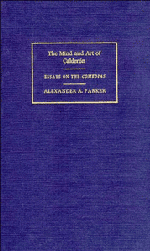Book contents
- Frontmatter
- Contents
- Author's preface
- Editor's preface
- Introduction
- I Stylistic and dramatic craftsmanship
- II From experience to myth
- III The tensions of social life
- 11 The functions of comedy
- 12 The vicissitudes of secrecy (1): La dama duende, El galán fantasma
- 13 The vicissitudes of secrecy (2): El astrólogo fingido
- 14 Secret betrothals and secret marriages: El postrer duelo de España
- 15 From comedy to tragedy: No hay cosa como callar
- 16 A Calderonian conception of tragedy: El pintor de su deshonra
- 17 The tragedy of honour: El médico de su honra
- IV The tensions of public life
- V From symbol to myth
- Epilogue
- Notes
- Index
11 - The functions of comedy
Published online by Cambridge University Press: 05 February 2012
- Frontmatter
- Contents
- Author's preface
- Editor's preface
- Introduction
- I Stylistic and dramatic craftsmanship
- II From experience to myth
- III The tensions of social life
- 11 The functions of comedy
- 12 The vicissitudes of secrecy (1): La dama duende, El galán fantasma
- 13 The vicissitudes of secrecy (2): El astrólogo fingido
- 14 Secret betrothals and secret marriages: El postrer duelo de España
- 15 From comedy to tragedy: No hay cosa como callar
- 16 A Calderonian conception of tragedy: El pintor de su deshonra
- 17 The tragedy of honour: El médico de su honra
- IV The tensions of public life
- V From symbol to myth
- Epilogue
- Notes
- Index
Summary
The preceding chapters have traced the development of a recurring theme in Calderon from his earliest plays to its gradual transformation in plot structure and technique, connected with the movement away from ‘real-life’ themes and actions towards the symbolism and abstractions of mythology, which are to dominate the last period of his dramatic output. It was suggested that this recurring theme must have been based on a traumatic experience in his boyhood, which he explored by means of dramatic art in a search for understanding and solution of the problems that this aroused for human living. While exploring these real-life problems at the start of his career, he also embarked on other themes, passing from the problems raised by family relationships to the problems raised by living in society. The life of society dominated the stage comedies in all countries that had a well-developed theatrical form of entertainment. The comedies of seventeenth-century Europe exemplified the ‘comedy of humours’ and the ‘comedy of manners’. These had their counterparts in Spain, though the ‘comedy of manners’ did not develop the elegant sophistication of a Molière. Comedies of manners in their earliest Spanish forms grew into ‘comedies of intrigue’ which tended to outnumber the ‘comedies of manners’.
The comedy of humours was exemplified in Spain by what later was to be called the comedia de figurón, the nearest equivalent in Spain to a ‘humour’ play, namely a satirical piece in which some eccentric or extravagant character is satirised.
- Type
- Chapter
- Information
- The Mind and Art of CalderónEssays on the Comedias, pp. 133 - 142Publisher: Cambridge University PressPrint publication year: 1989

